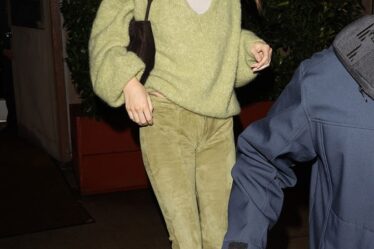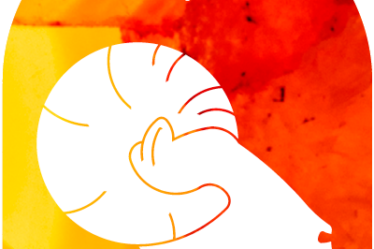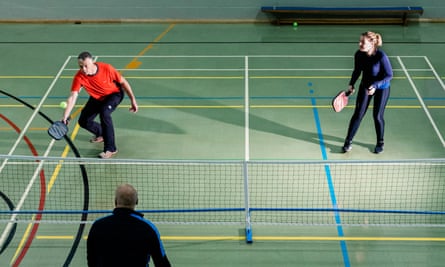
The sports hall of a school in New Malden, south-west London, may seem an unlikely venue for a revolution. But here, on an icy Thursday night, a revolution of sorts is taking place. Comrades are facing off, honing their skills and sharpening their reflexes.
A group of raw new recruits, a motley rabble of women and men sucked inexorably into the cause, looks on. The local commander, a no-nonsense but cheerful woman named Lou, will take them to the end of the hall to issue them with equipment, show them how to use it, and explain the rules of combat.
I say them. I mean us – for I am one of these raw recruits. And our weapons? Not muskets and bayonets, but paddles and wiffle balls. Paddles are like outsize table tennis bats, those cheeseboards with handles or, indeed, paddles. A wiffle ball is a light plastic one with holes (not to be confused with a Harry Potter quaffle).
Welcome to the pickleball revolution.
Pickleball is a cross between tennis, badminton and ping pong, played indoors or out, on a court about a quarter the size of a tennis court, and with a slightly lower net. It was invented by three dads on Bainbridge Island, near Seattle, in 1965 for their children, and is now the fastest-growing sport in the US. More than a million Americans took it up during the pandemic, bringing the total to nearly 5 million, among them Melinda and Bill Gates, various Kardashians, Friends’ Matthew Perry and Leonardo DiCaprio.
And it’s now over here. The school sports hall in New Malden is just one of 270 pickleball venues in the UK, and there are now estimated to be about 7,000 players. Pickleball England is aiming for 25,000 members by 2025. Two of the regulars here, Emma Robbins and Elaine Brown, both in their 50s, tell me why they like it. “It’s such an easy game to pick up, there aren’t too many rules, and before you know it you’re having a little dink,” says Emma.
I, too, am hoping to have a little dink soon, whatever one of those is …
“It’s good exercise, it’s strategic, it can be as hard or as easy as you want it to be, and most of the time it’s just good fun,” adds Elaine.
The size of the courts and the weight and speed of the ball (all less than in tennis), mean the learning curve is less steep. It’s easier on the body, and it’s a game for all ages: over there is Alan, in his 80s. Johnny is 24, and that’s his dad, Patch. Elaine has brought her son Joe, who’s 23, for the first time. “She’s been banging on about it for ages,” he moans.
Pickleball is a family thing, and a social thing, inclusive and friendly. Emma’s partner is cheerful Lou – Louise Fournilier Stephens – head coach of London Pickleball. Does she mean her doubles partner? No, partner partner. “We met through pickleball,” says Emma. Of course, who needs apps when there’s pickleball? Oh, and Elaine is national over-50s women’s double champion.
Right, it’s time for us virgins to get involved. We’re Joe, retired Chris, who’s 69, Gail and Dan, Anita and Neil, Sam from the Guardian, and Militsa from Bulgaria. Lou shows us how to hold the paddle – much as you’d hold a ping pong bat, though it’s best to keep fingers off the flat surface otherwise they might get wiffled – and we practise pickleball keepy-uppy, hitting the ball up with one side of the paddle then the other.
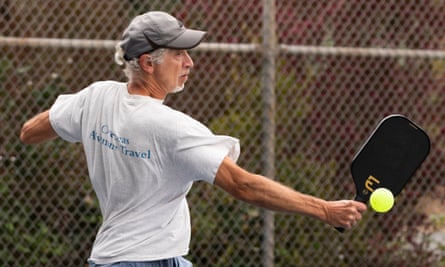
The hall echoes with a percussive cacophony, the thwack of paddle on perforated plastic, the squeak of trainer sole on gym floor, as well as a warm buzz of chitchat, banter and bonhomie.
Next comes the dink, an up-and-over-the-net shot. Up and over, up and over. The area near the net is known as the no-volley zone. (“Guess what you’re not allowed to do here?” says Lou.) The area is also known as the kitchen: no one knows why, though most people have a joke about it, usually involving men not putting in an appearance in it enough, except perhaps at parties.
In doubles, then, you can’t have one of you hanging out at the net, smashing anything that comes your way. The serve is underarm, more about starting a point than trying to win it – an ace is rare in pickleball. The return has to bounce, too, so no Navratilova-style serving and volleying, please.
We are soon actually playing proper games, with some half-decent rallies, even though we have been learning for no more than 45 minutes. You don’t get to this stage in tennis for years; to be honest, I never really have done. In between points (you play to 11; only the serving side can score) we tap paddles with our partners, sportingly and encouragingly. What, even if we’ve lost the point and it’s all their fault?
And now I’m wondering if it’s maybe all a teeny bit too … nice? I mean, fine in a Florida retirement village, y’all have a nice day (even though it may well be your last). But here, on the mean streets of … [checks notes] the Royal Borough of Kingston upon Thames, do we not perhaps want a bit more attitude in our exercise? I’m considering throwing a Nick Kyrgios wobbly: how easy is it to smash up one of these carbon-fibre paddles?
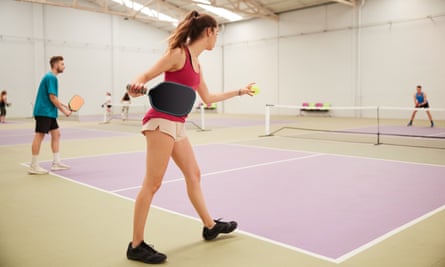
Plus there’s the elephant in the sports hall: that name. There are a couple of stories as to how it came to be called pickleball. One is that the family dog of one of those dads on Bainbridge Island was called Pickles. The other is that it’s a reference to something in rowing called a pickle boat, which is a crew of mixed abilities … But then, no one’s heard of a pickle boat, so most people go with the dog story, even though it’s less likely to be true (not least because when the game was born, Pickles the dog was yet to be).
Anyway, it’s a problem isn’t it, for a sport to be called pickleball if it wants to be taken seriously? No self-respecting kid is going to want to play pickleball, are they, or dream of one day being a pickleballer?
None of this seems to be an issue for anyone else in my group: they think the name is both amusing and fitting. Lou says pickleball gets very competitive, pointing to the doubles match on the next court which has turned into an epic pinball volley’n’dinkathon.
They are also getting some serious exercise. I feel as if my workout has been quite gentle, but that’s the thing about pickleball – you can play at any level. As my level increases, I will play with greater intensity. And it will, and I will. Because it turns out I’m brilliant at pickleball, a total natural, nimble of foot and thought, powerful and masterful on the forehand, cunning on the back, and the deftest of dinkers. The only thing that might need a little work, Lou thinks, is the attitude.
OK then, sign me up. Viva la revolución.
TWO MORE NEW SPORTS TO TRY
Teqball
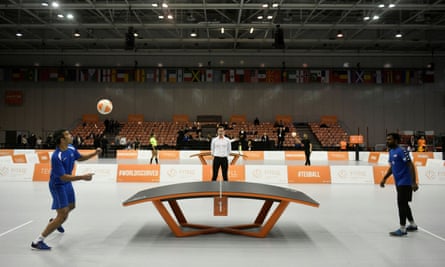
What?
A cross between football, table tennis and the south east Asian sport sepak takraw. Played on an arched table, players use any part of their bodies apart from arms and hands to hit a football over the solid net. As the name suggests, Teqball is technical, requires athleticism and coordination and can involve outrageous skills and fancy footwork. It is gender equitable.
Where?
Teqball was invented in Hungary in 2012 by former footballer Gabor Borsanyi while messing about with a ball and a table tennis table. It has established followings across Europe and in Brazil. Efforts are being made to include it in forthcoming Olympics.
Who?
Teqball was officially launched in Budapest in 2016 by Brazilian footballer Ronaldinho, since when David Beckham, Luís Figo, Lional Messi and Neymar have all got involved, and many European football clubs, including Brighton & Hove Albion have tables at their training grounds. A table costs from about £1,500.
Say what?
Shane Black, director of Iron Man 3: ““This is to me the future of keeping your kids fit.”
Padel
What?
A cross between tennis and squash. Courts are smaller than tennis courts, can be indoor or out and are enclosed, so the ball can be played off the walls, made of wire mesh and glass. Confusingly, padel uses rackets, not paddles, but they are solid (with holes) rather than stringed; the ball is slightly softer than a tennis ball. Usually played in doubles, it’s fast-paced, accessible and social.
Where?
Padel was invented in Mexico in 1969. It is popular in Argentina, Brazil, Ecuador, Chile and Panama; is big in Sweden, Portugal, Italy, the Netherlands, UAE and Qatar; and massive in Spain, where 4 million people play. And Padel is growing fast in the UK, which has about 250 courts and 90,000 players according to the Lawn Tennis Association.
Who?
Jürgen Klopp is a big fan, it’s his second favourite sport and they have a court at Liverpool’s training centre. Club captain Virgil van Dijk, who has seen it taken off in his native Nethrlands, is helping spread the word.
Say what?
Former British tennis No 1 Annabel Croft: “Each time I play padel, I come off with a big smile on my face.”


